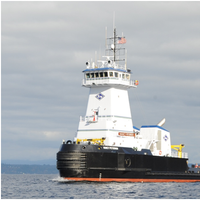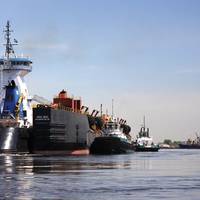New ATB Tug Built for Kirby

Nichols Brothers Boat Builders (Nichols Boats), located in Freeland, Wash., recently completed the M/V Nancy Peterkin, a 136’ x 44’ x 23’, 10,000 HP ATB Tug for Kirby Offshore Marine (Kirby), located in Houston, Texas. The Nancy Peterkin, built for Kirby Offshore Marine, was designed by Guarino & Cox using a round bridge hull form for optimum sea keeping and propulsive efficiency, the builder said. She is to couple into a 185,000 barrel barge built at Gunderson Marine in Portland, Oregon. This vessel will handle barges in full-ocean service.
Demand for Coastal and Transoceanic ATBs Grows

Along the way, ATBs gain speed, efficiency, safety – and popularity. Operators of articulated tugs and barges, or ATBs, say they like the maneuverability, weather reliability, stability, speed of these units, and the manner in which the tug pushes the barge. As a marine transportation concept, they can also simply be described as versatile. ATBs move petroleum, chemicals, coal, grain, containerized cargo and rail cars for customers on the U.S. coasts, rivers, the Great Lakes and overseas. As a result, demand for articulated units expanded in the last two decades with new technology.
Alabama Shipyard Delivers Second ATB
Alabama Shipyard has delivered another articulated tug and barge (ATB) unit to Reinauer Transportation Companies of Staten Island, N.Y. The Christian Reinauer and the RTC 143 is the second ATB unit built for Reinauer at Alabama Shipyard’s facility in Mobile. The first ATB unit, the Nicole Leigh Reinauer and the RTC 135 was delivered by Alabama Shipyard in December 1999. The 7,200 hp twin-screw ocean-going tug is 124 ft. and features the patented Intercon tug/barge coupler system designed and built by Intercontinental Engineering and Manufacturing Corporation of Kansas City, Mo. The system consists of two independently mounted gear drive ram assemblies that connect the tug and barge. The connection is transversely rigid and mechanically locked.
Double Skin is In
The movement of petroleum products on the nation's rivers, lakes, bays and oceans is soon to be regulated of the Oil Pollution Act of 1990. Called OPA 90, this regulation requires many bulk carriers of petroleum products to use double-hulled barges to haul their cargo by 2005 and all to be doubled hulled by 2015. Looking first at the large product tankers and crude oil carriers, 23 product carriers and 17 crude oil carriers must be double hulled by 2005, another 20 product carriers and 17 crude oil tankers need to be double hulled by 2010 and another 13 product and 9 crude oil ships need to meet OPA 90 by 2015. These conversions (or ship retirements) are a major issue impacting the ability of the U.S. to transport crude oil and its refined products.
Atlantic Marine Wins Second Reinauer Tug/Barge Contract
Atlantic Marine, Inc. has received a contract for a second state-of-the-art articulated tug and barge (ATB) vessel to be built at its Alabama Shipyard facility in Mobile, according to Dick Wells, President. This will be the second ATB to be supplied to Reinauer Transportation Companies headquartered in Staten Island, New York. "We were awarded this contract to build a second ATB for the Reinauer Transportation Companies for three reasons. First, the performance of the first ATB has been excellent, fully meeting the requirements of Reinauer's customers. Second, Alabama Shipyard has worked hard to support the first ATB to ensure that Reinauer is a fully satisfied customer.
Alabama Shipyard Signs Another Tug/Barge Contract
Alabama Shipyard has signed a contract to build an articulated tug and barge (ATB) vessel for Allied Transportation Company of Norfolk, Va. Both vessels will be designed and built to ABS classification standards. "This is our third major contract award during the last four months of 2000," said Dick Wells, the yard's president. "The total value of these contracts is greater than $65 million. Alabama Shipyard designed the 129,000-barrel, 450-ft. (137.1 m) barge in compliance with the Oil Pollution Act of 1990 ("OPA 90"), which requires vessels to have a "double-hull" in order to provide greater safeguards to the marine environment. OPA 90 requires most large coastal barges operating in the petroleum and chemical trade to have double hulls by 2005. Measuring 124 ft.
Alabama Shipyard Sign Contract for ATB
Alabama Shipyard has signed a contract to build an articulated tug and barge (ATB) vessel for Allied Transportation Company of Norfolk, Va. Both vessels will be designed and built to ABS classification standards. "This is our third major contract award during the last four months of 2000," said Dick Wells, the yard's president. "The total value of these contracts is greater than $65 million. Alabama Shipyard designed the 129,000-barrel, 450-ft. (137.1 m) barge in compliance with the Oil Pollution Act of 1990 ("OPA 90"), which requires vessels to have a "double-hull" in order to provide greater safeguards to the marine environment. OPA 90 requires most large coastal barges operating in the petroleum and chemical trade to have double hulls by 2005. Measuring 124 ft.
Alabama Shipyard Signs Tug/Barge Contract
Alabama Shipyard has signed a contract to build an articulated tug and barge (ATB) vessel for Allied Transportation Company of Norfolk, Va. "This is our third major contract award during the last four months of 2000," noted Alabama Shipyard president Dick Wells. "We have several pending contracts that will help us create a stable workforce here in Mobile," Wells stated. Alabama Shipyard designed the 129,000-bbl, 450-ft. barge in compliance with the OPA 90, which requires vessels to have a double-hull in order to provide greater safeguards to the marine environment. OPA 90 requires most large coastal barges operating in the petroleum and chemical trade to have double hulls by 2005.
Moran Moves Towards DH Fleet
With the introduction of three new double-hull petroleum barges in 2005, Paul Tregurtha, chairman of Moran Towing Corporation, announced that the company is on track to achieve its goal of operating an all double-hull fleet by the end of 2006. In the first seven months of 2005, Moran introduced two newly built double-hull petroleum barges, New Hampshire and Georgia, both built at Bay Shipbuilding in Wisconsin, and a newly converted double-hulled barge Massachusetts, delivered from Gulf Marine Repair in Florida. The three barges, with a combined cargo carrying capacity of 360,000 barrels, were matched with ocean-going tugs from the Moran fleet, all with articulated (ATB) coupler systems that allow the tug to remain permanently in the barge notch when underway.
The Petroleum Connection
All of the growth markets in the commercial marine marketplace have something to do with petroleum. Supply and crew/supply boats directly support drilling activity and Articulated Tug Barges (ATB) distributes crude, refined or an oil byproduct to refiners or distributors. The ATB represents a big advance in transporting these oil products over a pushboat pushing a tow of petroleum barges. Typically an ATB is one large barge with capacity from 80,000 to 160,000 barrels being pushed by a tug that fits into a notch in the barge. An advanced coupling system permits easy coupling and uncoupling of the two units. With typical barge and pushboat units, the coupling system uses winches and wire ropes to lash the barges together and also secure the barge tow to the pushboat.
The ATB:A History of the State-of-the-Art
(This is Part I of a two-part series on the Articulated Tug Barge from Robert P. Hill. The American coastwise shipping business has grown in a way that differs from many other nations. The high cost of manning and building ships has led over the years to a coastwise transportation network dominated by tugs and barges. • Weather delays caused by the uncertainties of towing of a barge in heavy weather, especially a barge carrying petroleum and chemical products, are a constant problem. Towing a large barge in heavy seas just off the coast is a risky business. The possibility of parted towlines, (not to mention the reality in several hundred cases) and lost, drifting barges, has haunted tug and barge operators - as well as the customers they serve - for years.
Tanker Trends: ATB Construction Forges Ahead …. Just Not at Torrid 2002 Pace
Construction of Articulated Tug Barge units (ATB) continues to occupy a prominent place in the order books of several shipyards. However the pace of current building and back ordered units is not as high as the 2000-2002 period. "It looks like we are in for a little 'breather' for a while," said Allen Craft, senior vice president of Intercontinental Engineering-Manufacturing Corporation, Kansas City, Mo. The company manufactures Intercon, one of the most popular couplers between the tug and the barge, which makes the ATB concept workable. "Vessel Management Services, a division of Crowley Maritime was a major driving force in this market when they had two different yards each built two ATBs with 9,280 hp tugs and 155,000 barrel barges using our couplers," Craft said.
Alabama Shipyard to Build ATB
Alabama Shipyard, Inc., has signed an agreement with Reinauer Transportation Companies to build an articulated tug barge unit (ATB) with an option for up to three additional units. The 460-ft. barge, designed by Alabama Shipyard, is double-hulled in compliance with OPA 90 regulations. Bob Hill of Ocean Tug and Barge Engineering, designed the 7,200 hp, 124-ft. tug. The ATB features the patented Intercon tug/barge coupler system designed and built by Intercontinental Engineering and Manufacturing Corp., of Kansas City. The system consists of two independently mounted gear-driven ram assemblies, which connect the tug and barge. The connection is rigid and mechanically locked, resulting in a vessel that handles like a conventional ship.
U.S. Builders Make Waves At Year End
While consolidations and closures continue to reshape the ship and boatbuilding industry worldwide, 1999 ended on some positive notes, particularly for ship and boat building companies in the United States. U.S. builders, who have watched U.S. Navy business dwindle for more than a decade, have – with the help of the U.S. Maritime Administration – invested hundreds of millions of dollars and an endless amount of effort to restructure their shipyard’s structures, machinery and work flows. The result: a smaller but more capable base of companies that are geared to fulfill demands of traditional clients down the block as easily as they fulfill the demands of customers around the world. The efforts of many U.S.
ATB Delivered by Alabama Shipyard
Alabama Shipyard, Inc. delivered Nicole Leigh Reinauer and RTC 135, an articulated tug/barge (ATB) unit, built for Reinauer Transportation Companies of New York. Alabama Shipyard designed the 135,000 barrel, 460-ft. double-hulled barge in compliance with OPA 90 regulations. Bob Hill of Ocean Tug and Barge Engineering designed the 7,200 hp twin-screw 124 ft. tug, built by Alabama Shipyard's sister company, Atlantic Marine. The ocean-going tug/barge unit features a patented Intercon tug/barge coupler system designed and built by Intercontinental Engineering and Manufacturing Corporation of Kansas City. The system consists of two independently mounted gear-driven ram assemblies which connect the tug and barge.
U.S. Builders Make Waves At Year End
While consolidations and closures continue to reshape the ship and boatbuilding industry worldwide, 1999 ended on some positive notes, particularly for ship and boat building companies in the United States. U.S. builders, who have watched U.S. Navy business dwindle for more than a decade, have – with the help of the U.S. Maritime Administration – invested hundreds of millions of dollars and an endless amount of effort to restructure their shipyard’s structures, machinery and work flows. The result: a smaller but more capable base of companies that are geared to fulfill demands of traditional clients down the block as easily as they fulfill the demands of customers around the world. The efforts of many U.S.





